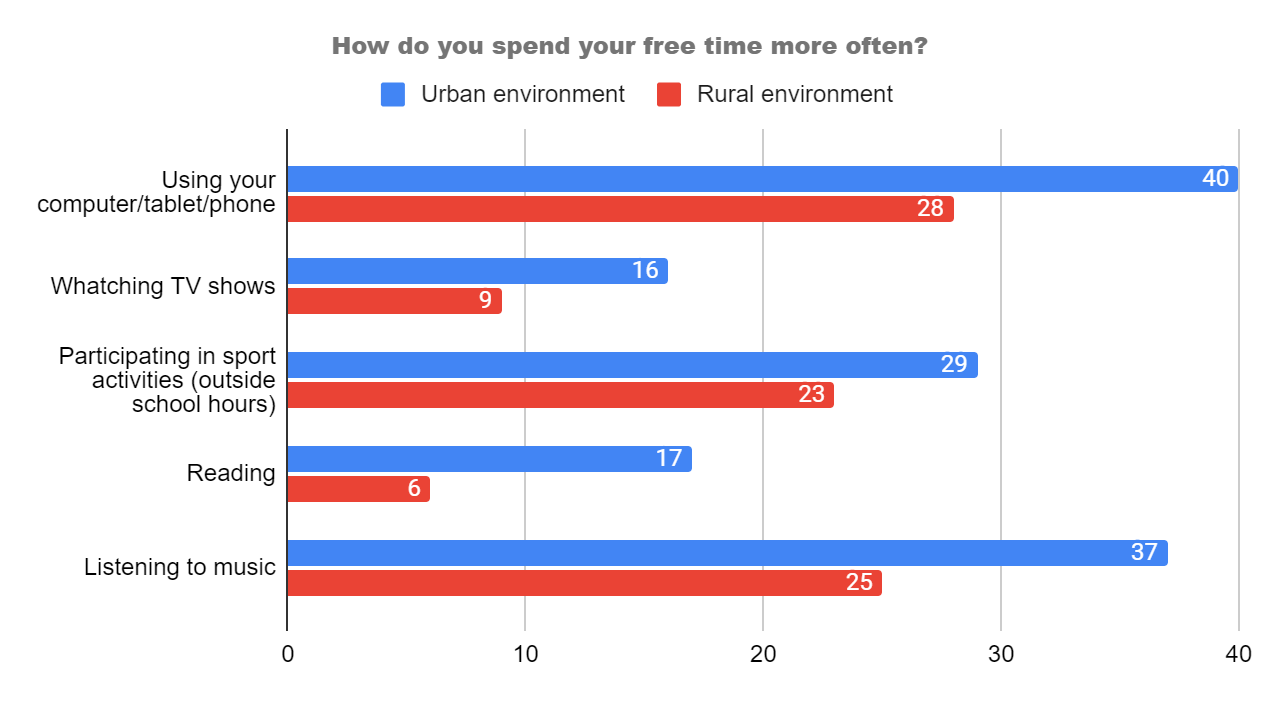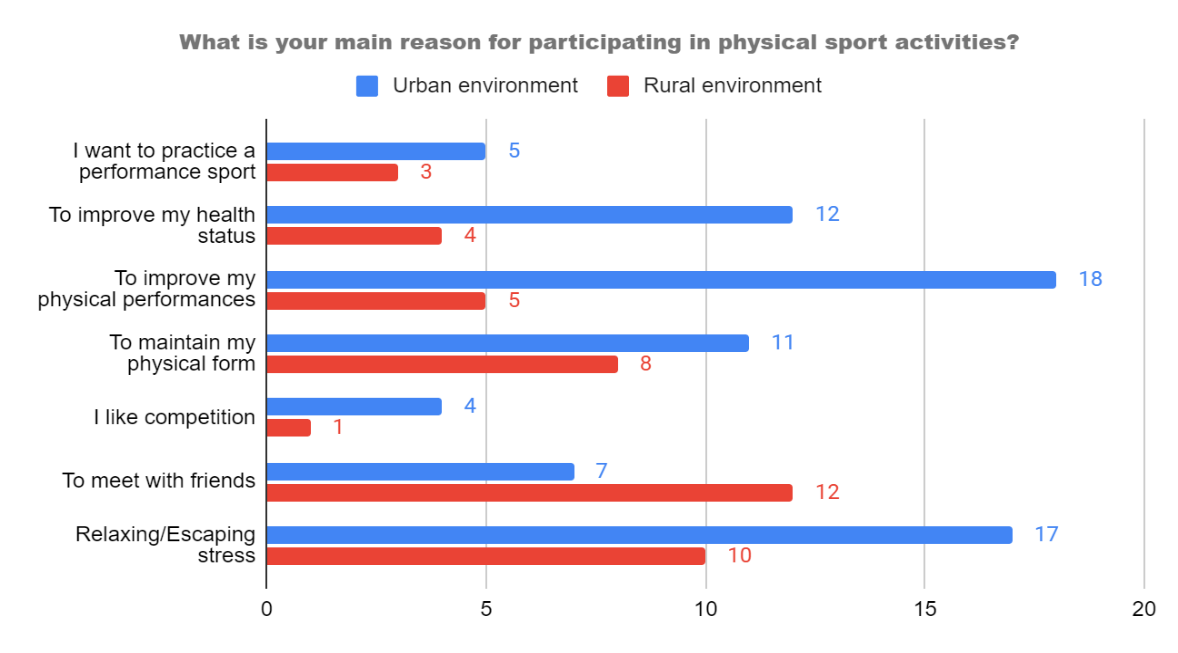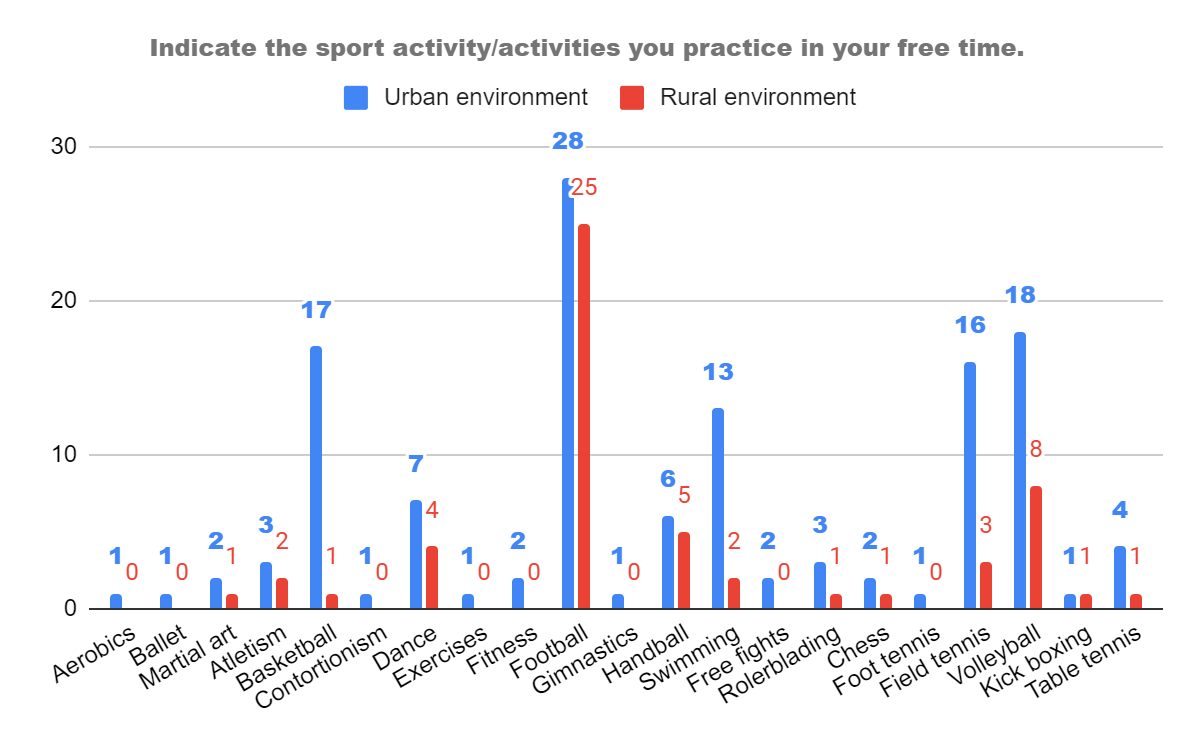Abstract
The purpose of this study is to identify and analyse extracurricular and out-of-school activities that secondary school pupils engage in, and to observe their tendency to exercise in their free time. As a research method, the survey method was used; by applying an online questionnaire in 3 urban and 3 rural secondary schools.Only half of the pupils surveyed, both in urban and rural areas, engage in physical activities of a sporting nature on a daily basis or 3-5 times a week, and the rest, although they have enough free time to engage in physical sporting activities, rarely do so, if at all. Even so, the thought of doing more sport at some point exists. Our study reinforces the idea that school is one of the most favourable environments for physical sporting activities, providing a safe and secure environment, both in the context of sports classes, which are unfortunately insufficient, and especially in the form of extracurricular activities, precisely because this form of organisation, responds very well to the needs mentioned by the pupils in the questionnaire, giving them the opportunity to benefit from specially designed spaces, qualified people to guide them, and the much desired company of friends and classmates, thus enabling them to socialise and improve their physical fitness and health, all away from the negative influence of technology.
Keywords: Extracurricular activities, physical activity, secondary school children, sport
Introduction
“Physical activity is a complex, multidimensional behaviour” (Miles, 2007, p. 318), that includes the full range of human movement, from sports and exercise to everyday, educational, household, transportation, and leisure activities. It is defined as "bodily movement that is produced by the contraction of skeletal muscles and that substantially increases energy expenditure" (U. S. Department of Health and Human Services, 1996, as cited in Miles, 2007, p. 318).
Over the years, numerous studies have been conducted demonstrating the benefits of regular physical activity throughout life. The significance of regular physical activity in mediating effects of lifestyle diseases has been recognized for over five decades. Physical activity provides opportunities for improving physical, psychological and emotional wellbeing, reducing the risk of lifestyle diseases, relieving stress, increasing positive mood, enhancing life skills, reducing mental fatigue, increasing concentration and reducing the tendency for aggressive behaviour, according to Brymer and Davids (2016).
Piercy and Troiano (2018) point out that everyone, including children and adolescents, can gain the cardiovascular health benefits of physical activity. Physical activity is one of the best things people can do to reduce the risk of cardiovascular disease, progression of cardiovascular disease, or death from cardiovascular disease. The amount of physical activity that provides favourable cardio respiratory health and fitness outcomes is similar for men and women of all ages, including older people, as well as for adults of various races and ethnicities.
The big problem, however, is physical inactivity, described as "a state in which body movement is minimal and energy consumption approximates the resting metabolic rate" (Miles, 2007, p. 318). Young people aged 10-24 years, constitute 24% of the world’s population; investing in their health could yield a triple benefit, today, into adulthood, and for the next generation. Globally, 80% of adolescents are insufficiently active. Adolescent’s physical inactivity probably contributes to key global health problems, including cardio metabolic and mental health disorders (van Sluijs et al., 2021). The effects of physical inactivity in the population include obesity, high blood pressure, diabetes, back pain, poor joint mobility and psychosocial problems (Kiess et al., 2001; Francis, 1996; World Health Organization, 1997, as cited in Allender et al., 2006). Physical inactivity is a major public health problem in the developed world and is recognised as a global epidemic (Fox, 2004).
With the development of technology in almost all areas, people's lives have improved considerably: we communicate at a distance, we travel much faster, we can access any information we need at the click of a button - these are just some of the many benefits of the evolution of technology. As good as all the positive aspects of technology sound, the negative ones have emerged and tend to compete with the positive ones, "digitalisation and virtual entertainment being the megatrends of the 21st century, there is a reasonable concern about the role of physical education in the daily lives of children and adolescents" (Schmidt et al., 2020, p.1). Among these negative aspects are sedentariness and obesity, which unfortunately affect the young population the most. Thanks to this development in technology, with the advent of phones and other gadgets, children unfortunately prefer to spend most of their time in front of screens rather than playing games, leisure activities or sports.
Problem Statement
In the context of not being physically active, health problems and decreased immunity have started to appear among the young population. The study by Divyasree et al. (2018) reveals that "one in ten deaths globally is caused by risks related to physical inactivity" (p. 1). Specialists draw the attention of parents, children and adolescents to the importance of movement, especially outdoor movement being beneficial to their lives. Children and sport should be part of the same team.
We conducted this study to identify and analyse the extracurricular and out of school activities that middle school pupils engage in and to observe their tendency to engage in physical sports activities in their free time. Also, through this study we try to identify the main reasons why secondary school children do not practice as much sport as they should at their age.
Research Methods
As a research method, the survey method was used, through the application of an online questionnaire containing 14 questions, sent in the form of a link. This questionnaire was applied in the two educational environments, existing in our country. In the urban environment, the pupils surveyed came from three secondary schools in Bucharest sector 6 and 1, and in the rural environment, from two secondary schools in Prahova County and one secondary school in Ilfov County.
Another method used was the bibliographic study, which searched the literature for more information on leisure time physical activity.
The graphic method was used to interpret and explain the answers to the questionnaire.
Results
In the online questionnaire, 74 responses were recorded in urban schools (41% boys; 59% girls), while 43 responses were recorded in rural schools (60% boys; 40% girls), in both cases, the pupils were aged between 10 and 15.
Following the analysis of the answers given by pupils in the first part of the questionnaire, we find that sport and physical activities are liked by all pupils, except one from urban areas, and that performance sport is practised by 35% of the pupils surveyed from urban areas and 44% of pupils from rural areas.

In Figure 1, pupils' responses on how they spend their free time are highlighted. We can see how using gadgets is the main preoccupation of the pupils, followed by listening to music, and only then, in third position in the top of preferences, we find participation in sports activities.
The following questions in the questionnaire reveal that the majority of pupils in both urban and rural areas have enough free time for sports activities. However, outside of physical education classes, only about half of the pupils (37 urban pupils; 26 rural pupils) did sport yesterday or today, one third (28 urban pupils; 10 rural pupils) did sport a few days ago and the rest a month ago or even later. Disturbingly, only about half of the pupils surveyed participate daily or at least 1 or 2 times a week in physical sport activities (including PE class), the rest rarely or never do so. Most pupils (37 urban and 17 rural) intend to do more sport from next month, while the rest (22 urban and 14 rural) are not yet decided and (11 urban and 8 rural) hope to do more sport in the next 6 months

The graphic in Figure 2 gives us information on the main reasons that lead the pupils in this study to participate in physical sport activities. If in rural areas the main reason is the opportunity to meet friends, in urban areas the main reason is to improve physical performance, with relaxation and stress reduction being in the next position in both cases.
Regarding the place where pupils practice sports activities in their free time, it is observed that in urban areas, most of them, 26 in number, practice sports activities on designated fields, while in rural areas, most pupils, 13 in number, prefer to do sports at home. A few prefer to do sport in parks or fitness centres. Regardless of location, the most enjoyable way to do sport is in the company of friends, with schoolmates and family members being the next most popular in urban areas, as opposed to rural areas, where pupils do sport alone.
In the last part of the questionnaire, we wanted to find out which sports activities children do in their free time. Thus, analysing the answers according to the chart in Figure 3, we observed that urban pupils practice a more diversified range of sports activities, 21 in number, unlike rural pupils, who only practice 13 sports activities. In both environments, football is the most practiced sport, followed by volleyball, basketball, field tennis and swimming in urban areas and volleyball, handball and dance in rural areas. If given the opportunity to play sport in both, urban and rural areas, football, swimming, volleyball, basketball and martial arts are the top choices.

When asked why they do not participate in sports in their free time, the main reasons reported were that they did not think of doing so, lack of partners, the fact that their friends are no longer interested in sports or lack of motivation. On the other hand, the aspects that would help them to participate more often in physical sports activities in their free time, according to the ticked answers, would be, for both urban and rural pupils, partners, guidance from knowledgeable people, and the inclusion of sports activities in the daily routine.
After analysing the answers given by the pupils in the questionnaire, we noticed that there is not a big difference between urban and rural secondary school pupils, physical activities and sports are no longer among their preferences, being replaced too much by the use of gadgets. Only half of the pupils surveyed, both urban and rural, engage in physical activity of a sporting nature on a daily basis or 3-5 times a week, and the rest, although they have enough free time to engage in physical sporting activities, rarely do so, if at all. Even so, the thought of doing more sport at some point exists.
Discussions
A study by Eccles and Barber (1999) indicates a different impact of extracurricular activities, depending on their type and participation rate, as follows:
- participation in all types of extra-curricular activities correlates with increased school results and performance;
- participation in sport makes it more likely that pupils will choose to go to higher education (university level) before the age of 21;
- participation in pro social activities correlates with lower delinquency rates among participating pupils.
Extracurricular activities are very important for the harmonious development of the child. Research shows that they help pupils to form a positive attitude to learning, they perform better in school, they develop diversified practical skills and appropriate problem-solving strategies. On top of all this, extracurricular activities also have an impact on self-esteem and a greater sense of achievement. The long time spent with shaping, training and educating pupils leads to the goal of practicing extracurricular school activities. By achieving this goal, we can say that pupils are offered another way of learning experiences and developing special skills (Ionescu & Chiș, 2001, p. 11).
Conclusions
World Health Organization (2020) recommends:
Children and adolescents aged 5 to 17 years should do at least an average of 60 minutes per day of moderate to vigorous intensity, mostly aerobic, physical activity, across the week. Vigorous intensity aerobic activities, as well as those that strengthen muscle and bone, should be incorporated at least 3 days a week. (p. 25)
Globally, extracurricular sports activities in schools have been widely recommended to encourage adolescent participation in physical activities and sports (Aoyagi et al., 2020). In order for as many children and adolescents as possible to meet the health recommendations for physical activity, the need arises to develop and implement strategies to promote an active lifestyle, with the encouragement of participation in sport as one possible strategy. In this regard, schools are considered to be the ideal places to implement such strategies, as children from all socioeconomic backgrounds, spend a considerable amount of time at school (De Meester et al., 2014).
In the Romanian educational system, extracurricular activities are complementary activities to the teaching approach provided by the Framework Plan and the National Curriculum. These activities may be scientific, artistic, sporting or vocational in nature and may take place inside or outside educational institutions. They are a way for pupils to develop certain skills and competences in a less rigid way, using modern strategies which stimulate their creativity and interest in a particular field. They contribute greatly to pupils' social and personal development (Jioară & Bîrsan, 2019).
Our study reinforces the idea that school is one of the most favourable environments for physical sports activities, providing a safe and secure environment, both in sports classes, which are unfortunately insufficient, and especially in the form of extracurricular activities, precisely because this form of organization, responds very well to the needs mentioned by the pupils in the questionnaire, giving them the opportunity to benefit from specially designed spaces, qualified people to guide them, and the much desired company of friends and classmates, thus enabling them to socialise and improve their physical fitness and health, all away from the negative influence of technology.
References
Allender, S., Cowburn, G., & Foster, C. (2006). Understanding participation in sport and physical activity among children and adults: a review of qualitative studies. Health education research, 21(6), 826–835. DOI:
Aoyagi, K., Ishii, K., Shibata, A., Arai, H., Fukamachi, H., & Oka, K. (2020). A qualitative investigation of the factors perceived to influence student motivation for school-based extracurricular sports participation in Japan. International Journal of Adolescence and Youth, 25(1), 624–637. DOI:
Brymer, E., & Davids, K. (2016). Designing Environments to Enhance Physical and Psychological Benefits of Physical Activity: A Multidisciplinary Perspective. Sports medicine, 46(7), 925–926. DOI:
De Meester, A., Aelterman, N., Cardon, G., De Bourdeaudhuij, I., & Haerens, L. (2014). Extracurricular school-based sports as a motivating vehicle for sports participation in youth: A cross-sectional study. The International Journal of Behavioral Nutrition and Physical Activity, 11(48). DOI:
Divyasree, P., Kumar, G. D., Subitha, L., & Ramesh, R. S. (2018). Level, motivation and barriers to participate in physical activity among late adolescents in Puducherry. International journal of adolescent medicine and health, 33(2). DOI:
Eccles, J. S., & Barber, B. L. (1999). Student Council, Volunteering, Basketball, or Marching Band: What Kind of Extracurricular Involvement Matters? Journal of Adolescent Research, 14(1), 10–43. DOI:
Fox, K. R. (2004). At least five a week: Evidence on the impact of physical activity and its relationship to health – A report from the Chief Medical Officer. https://research-information.bris.ac.uk/en/publications/at-least-five-a-week-evidence-on-the-impact-of-physical-activity-
Francis, K. (1996). Physical activity in the prevention of cardiovascular disease. Physical therapy, 76(5), 456–468. DOI:
Ionescu, M., & Chiș, V. (2001). Mijloace de învățământ și integrarea acestora în activitățile de instruire și autoinstruire [Learning resources and their integration into training and self-learning activities]. Presa Universitară Clujeană.
Jioară, M., & Bîrsan, E. (2019). Managementul activităților extracurriculare [Management of extracurricular activities]. Materialele conferinţei ştiinţifice a studenţilor (pp. 203-208).
Kiess, W., Galler, A., Reich, A., Müller, G., Kapellen, T., Deutscher, J., Raile, K., & Kratzsch, J. (2001). Clinical aspects of obesity in childhood and adolescence. Obesity reviews: an official journal of the International Association for the Study of Obesity, 2(1), 29–36. DOI:
Miles, L. (2007). Physical activity and health. Nutrition Bulletin, 32(4), 314-363. DOI:
Piercy, K. L., & Troiano, R. P. (2018). Physical Activity Guidelines for Americans from the US Department of Health and Human Services. Circulation. Cardiovascular quality and outcomes, 11(11), e005263. DOI:
Schmidt, S., Anedda, B., Burchartz, A., Oriwol, D., Kolb, S., Wäsche, H., Niessner, C., & Woll, A. (2020). The physical activity of children and adolescents in Germany 2003-2017: The MoMo- study. PloS one, 15(7), e0236117. DOI:
U. S. Department of Health and Human Services. (1996). Physical Activity and Health: A Report of the Surgeon General. Atlanta, GA: U.S. Department of Health and Human Services; Centers for Disease Control and Prevention; National Center for Chronic Disease Prevention and Health Promotion. https://www.cdc.gov/nccdphp/sgr/pdf/sgrfull.pdf
van Sluijs, E., Ekelund, U., Crochemore-Silva, I., Guthold, R., Ha, A., Lubans, D., Oyeyemi, A. L., Ding, D., & Katzmarzyk, P. T. (2021). Physical activity behaviours in adolescence: current evidence and opportunities for intervention. Lancet, 398(10298), 429–442. DOI:
World Health Organization. (1997). Obesity: Preventing and managing the global epidemic: report of a WHO Consultation on Obesity. World Health Organization. https://apps.who.int/iris/handle/10665/63854
World Health Organization. (2020). WHO guidelines on physical activity and sedentary behavior. World Health Organization. https://apps.who.int/iris/handle/10665/336656
Copyright information

This work is licensed under a Creative Commons Attribution-NonCommercial-NoDerivatives 4.0 International License.
About this article
Publication Date
10 April 2023
Article Doi
eBook ISBN
978-1-80296-961-0
Publisher
European Publisher
Volume
5
Print ISBN (optional)
-
Edition Number
1st Edition
Pages
1-1463
Subjects
Education sciences, teacher education, curriculum development, educational policies and management
Cite this article as:
Coroiu, A., & Dintica, G. (2023). Study on Extracurricular Activities Practiced by Secondary School Children. In E. Soare, & C. Langa (Eds.), Education Facing Contemporary World Issues - EDU WORLD 2022, vol 5. European Proceedings of Educational Sciences (pp. 1323-1330). European Publisher. https://doi.org/10.15405/epes.23045.134

